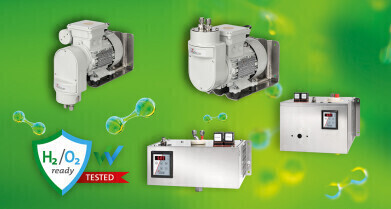Analytical Instrumentation
Hydrogen components for gas analysis
Dec 08 2023
Hydrogen (H2) is one of the key talking points in discussions on future energy policy. In its gaseous form, it is approximately 14 times lighter than air and leaves no residue when burnt. With its high energy density, H2 is a very credible alternative to fossil fuels such as coal or natural gas. H2 is usually only naturally present in bound form, so it must be released from its carriers. In the case of water (H2O), this is carried out by electrolysis, for example. If electricity is generated from renewable sources, we describe it as 'green' hydrogen or, in the case of methane (CH4), the main component of natural gas, by steam reformation or pyrolysis. Reformation produces CO2 or blue hydrogen, as a by-product or, if pyrolysis is undertaken, CO or turquoise hydrogen. Both substances can undergo further processing as raw materials or stored by carbon capture and storage (CCS).
H2 is extremely volatile because of its very low density, so it is very volatile and poses problems for transportation to end-users. In its gaseous form, pipeline transportation is an option. Liquefied H2 can be transported in insulated tankers or tank trucks; however, non-negligible fluctuation rates will occur. H2 also embrittles materials, which need to be considered when working out the service life and design of plant components. Producers of 'green' hydrogen also need to ensure that not only is sufficient 'green' electricity available, but enough, decent quality water is available at the production location.
How does an electrolyser work?
At the heart of an electrolyser is a cylindrical body, known as the electrolysis module, in which two chambers are separated by a membrane. Both chambers contain an electrode (anode/cathode). These modules are manufactured by several different manufacturers in a uniform output size. To attain the requisite system output, several modules are combined to create a ‘stack’. Two processes are currently in use: AEL - alkaline electrolysis and PEM -proton exchange membrane electrolysis. There are pros and cons to both processes. The PEM process is more suited to fluctuating energy sources such as wind and sun. With the PEM process water is preheated to drinking water quality, and is fed into the two chambers. The operational temperature has to range between 50-80°C. Voltage is applied and it is split into H2 and H20. This produces 1 kg of H2 from 9 kg of H2O. The oxygen is removed from the anode, and the hydrogen the cathode and anode with the use of heat exchangers and gas separators. The oxygen is then released or used for a variety of applications, such as wastewater treatment.
Monitoring the process
H2 manufacturing processes require precise analytical monitoring, primarily to comply with LEL and SIL criteria. Extractive gas analysis is the most widely used method for monitoring energy production. Before the sample gas reaches the analyser, residual moisture needs to be removed to avoid fouling the measuring cell and therefore generating false measured values.
O2 ATEX-certified sample gas pump
Buehler Technologies has many years of experience in the development and design of gas analysis systems, they strongly advocate the use of a pressurised extractive conditioning system for such applications. In principle, this is constructed as follows:
Their reasoning is based on the fact that no particulate contamination is likely to be present in the sample gas during the electrolysis process, so simple sampling points are needed at each module outlet. From these sample points, the sample gas is taken in by a sophisticated sample gas pump, which can also carry any condensate that may be present, and fed to a sample gas cooler working under slight over-pressurised conditions.
H2 ATEX-certified sample gas pump
When calculating the dimensions of the required flow rates, the lower density of hydrogen on the H2 side must be taken into consideration so that it can be passed through at the requisite flow rate upstream of the analyser. If the production process already has enough pressure and flow rate, the pump is not needed. The moisture is separated in the cooler and the dry sample gas is fed into the analyser(s). As the sample gas is slightly over-pressurised, measurement results are unaffected by ambient air entering the system. This sample gas over-pressure also pushes the condensate out of the system via an automated condensate drain. Flow and over-pressure are monitored permanently by suitable instruments to ensure the smooth operation of the process. The extraction point’s piping, from the pump head to the automatic condensate drain is made of tough stainless steel; Buehler recommends the same concept for monitoring oxygen that also accumulates. H2 has a high level of fluctuation so a well-ventilated enclosure to house the monitoring system is advisable. The components used in the system are subject to special procedures in the manufacturing process. Their suitability for the H2/O2 application is partially certified.
This system design keeps material mix in the treatment system to a minimum, therefore providing the longest service life possible, and ensuring stable and precise measurement results.
Digital Edition
PIN 25.1 Feb/March
March 2024
In This Edition Safety - The technology behind the ION Science Tiger XT - Safety with ammonia and LOHCs as hydrogen carriers Analytical Instrumentation - Discussion on new tribology te...
View all digital editions
Events
Apr 30 2024 Birmingham, UK
May 03 2024 Seoul, South Korea
May 05 2024 Seville, Spain
May 06 2024 Riyadh, Saudi Arabia
May 06 2024 Houston, Tx, USA


















